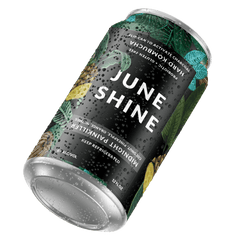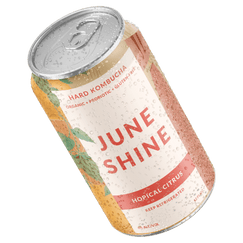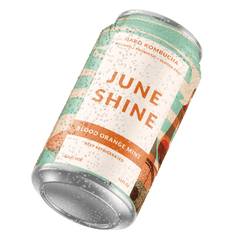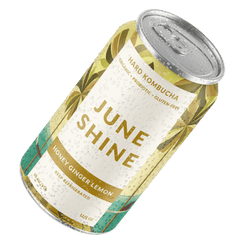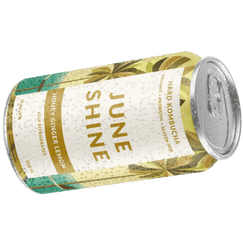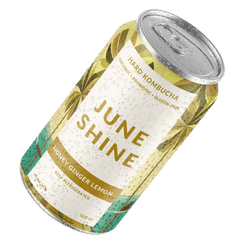Your Guide on How to Make Hard Kombucha

You may have tasted hundreds of batches of booch, or you may be interested in exploring the world of kombucha for the very first time. Kombucha has been around for over 2,000 years, starting in ancient China around 220 B.C. While the original method of making kombucha did not yield a particularly high volume of alcohol, we have tweaked the recipe slightly to give your booch that extra little kick.
There are a few tried and true steps to crafting the perfect batch of booch. From the supplies needed to the steps of fermentation and bottling, we’ve outlined the basics of how to make hard kombucha. We prefer hitting up our upcycled brewery for the process, but you can make kombucha pretty much anywhere.
Supplies for Making Hard Kombucha
There are only a handful of materials needed to brew this classic fermented tea. The essentials are:
- A container to hold your kombucha as it ferments
- A covering for the container
- Bottles once the batch is finished
A Large Container
You need a gallon-sized jar to contain the liquid as it ferments, ideally one that’s glass. Typically, a gallon is the standard size, but that isn’t a hard rule. The container just needs to be big enough for your SCOBY (we’ll explain that later) and tea mixture.
Some other less popular but still functional options are porcelain and ceramic containers. However, don’t use plastic containers to store brews. Plastic can introduce unwanted chemicals into the kombucha blend. No dice...
Covering the Container
Kombucha is a fermented tea drink, so it requires airflow. While it’s fermenting, the container needs some covering to keep out unwanted contaminants like fruit flies and bacteria.
The most commonly used covering is cheesecloth, but again — not a hard rule. As long as it covers the vessel and allows airflow, it’s acceptable.
Pressure-Resistant Containers
Kombucha needs airflow during the fermentation process, but the final containers must be airtight. Glass bottles are most commonly used for home brews.
Regardless of the material, the containers need to be leakproof and able to be refrigerated. This is a key final step in keeping the batch at the prime alcoholic and carbonation levels.
SCOBY
Any internet search for kombucha will undoubtedly lead you to information about SCOBY, sometimes known as the “mother of kombucha.” SCOBY stands for symbiotic culture of bacteria and yeast, and it is fundamental for the fermentation process of kombucha. It is also sometimes called the “starter” for kombucha.
SCOBY is the key to causing the beverage to ferment. Without it, you just have a tea mixture.
This key ingredient is a tan or yellow gelatinous pancake-sized disc, which converts sugars to alcohol in kombucha. You can purchase SCOBY, borrow it from a friend, or grow it from scratch.
Think of the SCOBY as the security guard for kombucha. It prevents any pests or unwanted bacteria from entering the container. As the delicious tea ferments, the SCOBY also maintains optimal bacteria and yeast levels in the vessel.
Usually, SCOBY sits atop the liquid in the brewing container, but it isn’t uncommon to see it hanging out sideways or partially submerged in the liquid.
Tea
The first step of making hard kombucha is brewing the base. Traditional kombuchas are made with black tea in boiling water and refined cane sugar for sweetness.
At JuneShine, we do things a little differently. We think green tea and organic honey make for a better product than the traditional black tea and sugar mixture.
Green tea has a gentler flavor than black tea, leaning to a smooth sip that doesn’t have the bite of the traditional stuff.
Fermentation
Once the tea base has been brewed and mixed with a sweetener (in our case, honey rather than sugar), it is time to let nature take its course with fermentation. Fermentation is a naturally occurring process that uses fungi and bacteria to convert sugars into alcohol and carbon dioxide.
This part of the process requires some patience. Generally, kombucha is left to ferment for anywhere between one and three weeks. The longer the fermentation, the less sweet of a taste. As sugars are broken down into alcohol, the flavor adjusts accordingly.
During this process, kombucha releases gases. This is why the cloth covering is necessary for adequate airflow. It is also the time that probiotics and carbon dioxide (fizziness) are introduced to the mix.
Fermentation Take Two
Traditional kombucha has very little alcohol in it. As they only contain less than 0.5%, kombuchas seen in the grocery store are labeled as non-alcoholic beverages. Homebrews contain about 1.5% alcohol by volume.
Our kombucha does contain alcohol: 6% ABV, to be exact. That is because we take our brews through an additional step of fermentation to give you a bolder buzz. The second fermentation process allows even more sugar to convert into alcohols and carbonation, which means more alcoholic content and a fizzier taste.
Bottling
The final step in making kombucha is to package the brew. Most commonly, home kombucha is bottled in flip-top glass bottles. These are aesthetically pleasing and hold a nice seal to prevent any carbon dioxide from escaping. Once in an airtight package, your kombucha won’t lose the fizziness you worked so hard to achieve.
At JuneShine, we prefer packaging our kombucha in aluminum cans. You can take cans anywhere, while glass may not be allowed into certain parks and venues. Plus, aluminum can be recycled an indefinite amount of times, so it’s a more environmentally friendly option.
Conclusion
So, you know how hard kombucha is made, but you’re not really interested in making it yourself. We got you.
If you’re looking for something tropical, we suggest Midnight Painkiller. With refreshing notes of tropical fruit juices, you can almost hear the waves crashing as you crack one open and take that first sip.
If you’re feeling like something hoppy, Hopical Citrus is your best bet. This one is a 4.5 out of 5 on the spicy scale, so don’t say we didn’t give you a heads up.
If your typical go-to drink is red wine, give our Acai Berry a try. Brewed with organic acai and blueberries, it gives the sweetness of wine but the refreshing quality of kombucha. Whether catching rays by the beach or enjoying a Sunday Funday, this one is a winner.
Now you have had an unofficial crash course on how to make hard kombucha. The steps and ingredients are pretty simple. We’ve cranked things up a notch in our booch game, and we have concocted our core flavors using real, organic spices and fruit juices. The final step is for you to figure out which flavor you’ll try first.
Sources:
10 Tools You Need to Brew Kombucha at Home | Food & Wine
Kombucha SCOBY: What It Is and How to Make One | Healthline
Kombucha Takes 2 to Tango | Scientific American Blog Network
